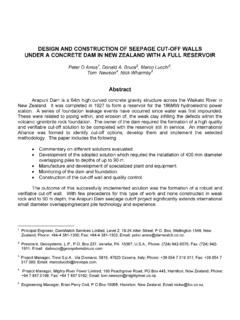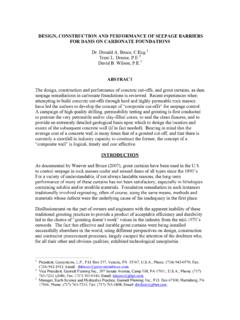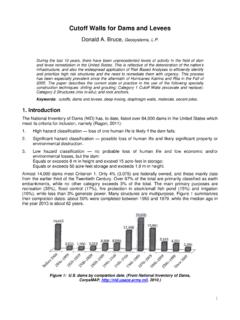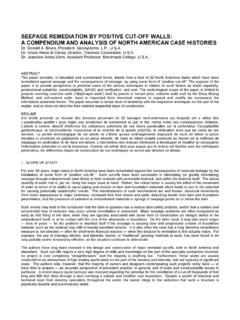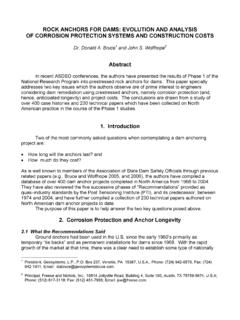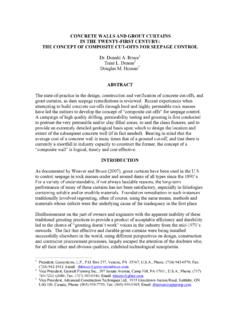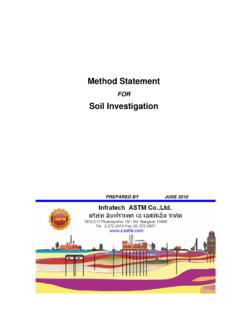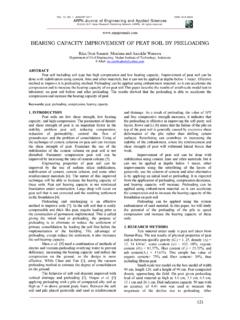Transcription of The Evolution of Small Hole Drilling Methods for ...
1 The Evolution of Small Hole Drilling Methods for geotechnical construction Techniques Dr. Donald A. Bruce1. ABSTRACT. The Evolution of Small hole Drilling techniques, in rock and soil , and as used in tieback, nail, and micropile construction since the early 1960's, is described. The successive classifications of Drilling techniques are described, as are the individual techniques which are now in common practice. Information is also provided on flushing characteristics, hole deviation, and recording of Drilling progress and parameters. 1. HISTORICAL CONTEXT. Writing in the seminal ASCE Conference on the Design and Performance of Earth Retaining Structures in 1990, Gould reviewed the technological developments which had taken place in that field up to 1970. The main impetus for change had come from the urban reconstruction of Europe abetted by their fashion of emerging innovation by the constructor. One example was the use of prestressed tieback anchors, first in rock, then in soil , and from temporary to permanent installations.
2 The first tiebacks in rock were installed in New York City and in Milwaukee in the 1960-1961 period, and in soil in Los Angeles in 1963, although the latter were initially helical or underreamed. Hollow stem augers were well suited to the alluvials of and routinely used. European Drilling developments using percussion and/or high torque rotation were used in the from the mid-1960's. O'Rourke and Jones (1990) then picked up the story for the 1970-1990 period, noting the surge in soil anchor use associated with metro construction throughout the country and especially in the older cities of the east and west coasts. He noted variations in Drilling devices have proliferated in an attempt to cope with different soil and groundwater conditions. Bruce (1989), for example, has described at least seven different classes of overburden Drilling , with modifications and special adaptations in each class.. In the subsequent 22 years, the Bruce simple seven classification has been progressively modified as new technologies have come to market for example sonic Drilling , and a number of concentric duplex systems while others have dropped out or become obsolescent, , the OD system.
3 1. President, Geosystems, , Box 237, Venetia, PA 15367, , Phone: 724-942-0570, Fax: 724-942-1911, O'Rourke and Jones (1990) were also kind enough to reference the historical research published in 1986 and 1987 by Bruce and Jewell regarding the Evolution of soil nailing in the the other major Drilling -related aspect of earth retention. Although there are reports of soil nailing being conducted in Western Canada, in the late 1960's, the first bona fide soil nail project appears to have been in Portland, Oregon, in 1976. Then, as now, soil nailing tended to feature simple and fast Drilling systems with continuous flight augers and (air flushed) rotary open hole Methods constituting most of the work. It is typically the case that if more sophisticated Drilling systems are needed, then soil nailing may not be the most appropriate or economic solution to an earth retention challenge. On the contrary, micropiles are frequently installed in ground conditions which render other (cheaper, more conventional ) deep foundation systems impractical, and indeed this is one of the fundamental attractions of using micropiles.
4 As described by Van Bares (2007), drilled and grouted micropiles were first introduced into the in 1970 by the Fondedile Company, from Naples, Italy. For various reasons, the technique was slow to catch on in the , particularly with the Departments of Transportation, potentially the biggest single group of clients for this technique . Just as Fondedile failed, despite heroic efforts involving several successive business models and partners, the same contractors who had become tieback specialists began to use the same Drilling and grouting techniques to exploit the growing potential for micropiles, in both the private and public sectors. Hence, from the early 1980's onwards, and particularly from the early-to-mid 1990's, micropiling grew at a very fast rate, supported in full measure by the skills and expertise of the Drilling equipment and systems manufacturers. More information on the Evolution of the micropile market can be found in Bruce and Juran (1997) and Bruce (2009).
5 This discussion of the Evolution of the three main Small hole Drilling markets of particular interest to most ADSC members puts in perspective the time scale over which developments in Drilling technology are described in this paper. It is the case, of course, that the same range of systems can be employed for Drilling grout holes and for installing geotechnical instrumentation. For ancient history on the development of Drilling systems, the reader is referred to other sources such as Acker (1974) and the Australian Drilling Industry Training Committee Ltd. (1997), among many others. It will be noted that these older texts focus on the Drilling of rock, since the major applications were for exploration, blast holes, grout holes for dam foundations, and water wells. As noted above, the need to drill overburden for earth support and for deep foundations is largely a post-1960 phenomenon, as we began to build on, through, and under materials other than rock.
6 2. SCOPE AND COMMUNALITIES. In the specialty geotechnical construction field, most holes are from 3 to 12 inches ( to 30cm) in diameter, and rarely penetrate more than 250 feet (76 m). Most are installed within 20 of vertical and within 30 below horizontal. They have to be installed in all types of ground, natural or placed, unconsolidated or lithified, and will often encounter obstructions, again either natural or artificial. Most Drilling is in materials below the water table and, in the case of tiebacks especially, is also commenced below the water table. Systems must be capable of assuring continuous, adequately straight penetration in all materials. They must provide a constant diameter, stable (or temporarily stabilized) path full depth, from which the Drilling debris has been fully removed, and which is consistent with the purpose of the hole. For example, a hole whose walls are required to transmit shear stresses could not be drilled with a mud flush.
7 Systems must be able to optimize the effectiveness of the flushing medium used. Most importantly, systems must be dictated by the ground conditions, cost notwithstanding, although historical bias, corporate culture and regional experience are too often powerful factors. Another major factor for consideration includes compatibility with the project-specific environmental considerations and restraints, including noise, vibrations and flush control and disposal. Above all, the Drilling system or process must not harm or distress the ground being drilled, or any preexisting structure in or on the ground: the principle rule of surgery must observed Primum, non nocere (First, cause no harm). 3. Evolution OF ROCK Drilling Methods . The state of practice at the dawn of the ADSC age is illustrated in Figure 1. This figure excludes consideration of rock coring which was, nevertheless, used in early dam anchoring projects to prove the quality of the rock in the bond zone (Bruce and Wolfhope, 2007 and 2007a).
8 Figure 1 Basic Drilling method selection guide for rock using non-coring Methods , Littlejohn and Bruce, 1977 (adapted from McGregor 1967). Clearly, the generic Methods were: Rotary high speed, low torque (coring or blind ). low speed, high torque Percussive top hammer down-the-hole hammer (air flush). A detailed discussion of these Methods is provided in Weaver and Bruce (2007). Most rock Drilling is now conducted with percussive Drilling and, in particular, with down-the-hole Drilling (DTH) for several reasons: DTH Drilling has higher and more consistent penetration rates (by several times);. It has lower Drilling costs;. It provides straighter holes; and It can provide holes of up to 40 inches (1m) in diameter to considerable depths (over 300 feet (90m)). Several important developments have occurred with DTH Drilling in the last 10 years or so in practice. These include: For conventional air-powered hammers and bits, very sophisticated computer programs and simulations are now being used to optimize performance, reliability, and durability, and to develop systems with particular characteristics, such as short hammers for restricted conditions.
9 It must also be noted that the typical air pressures of 160-250 psi of the 1970's have been replaced by pressures of up to 500 psi: penetration speeds have increased accordingly. Industrial productivities have also increased dramatically through better understandings of the metallurgy of hammers and bits, and the use of sophisticated concepts, , polycrystalline diamond coatings on the carbide bit inserts. Reverse circulation hammers are being developed with dual wall rods. These use air and, if required, can accommodate water misting also. Dual fluid system (DFS) hammers feature conventional air activation, but incorporate a central tube through the hammer body that permits water to be used for hole flushing. This has not had widespread application so far in the Water-powered hammers have been used in the underground mining industry in Scandinavia since 1986. Within the last 10 years they have become popular and accepted as the DTH method of choice for grout hole Drilling in rock (wherein air flush or misted flush is not permitted).
10 They tend to satisfy the smaller end of the DTH hammer range with typical hammer diameters being 3 inches (79mm), 4 inches (102mm), 4 inches (121mm), and 6 inches (152mm). As noted in Section 4, these, however, can also be used in simple percussive duplex mode to install casings through overburden of 4 to 8 - inch (114 to 219mm) diameter. Water-powered DTH hammers the most popular versions being built by Wassara use filtered water at pressures of up to 2,500 psi ( MPa), and flow rates of 50-75 gpm (190-285 l/min) to activate the hammers and flush the hole. They are reportedly more energy efficient than conventional air-powered hammers. Interestingly, because the uphole velocity of the (water) flush is significantly lower than the corresponding velocity of air (Section 5), more stabilizers can be placed on and around the drill string, promoting a straighter hole. A final development for rock Drilling which may be considered here is the rotary vibratory (or sonic) method, although it has so far seen most applications in overburden Drilling .
